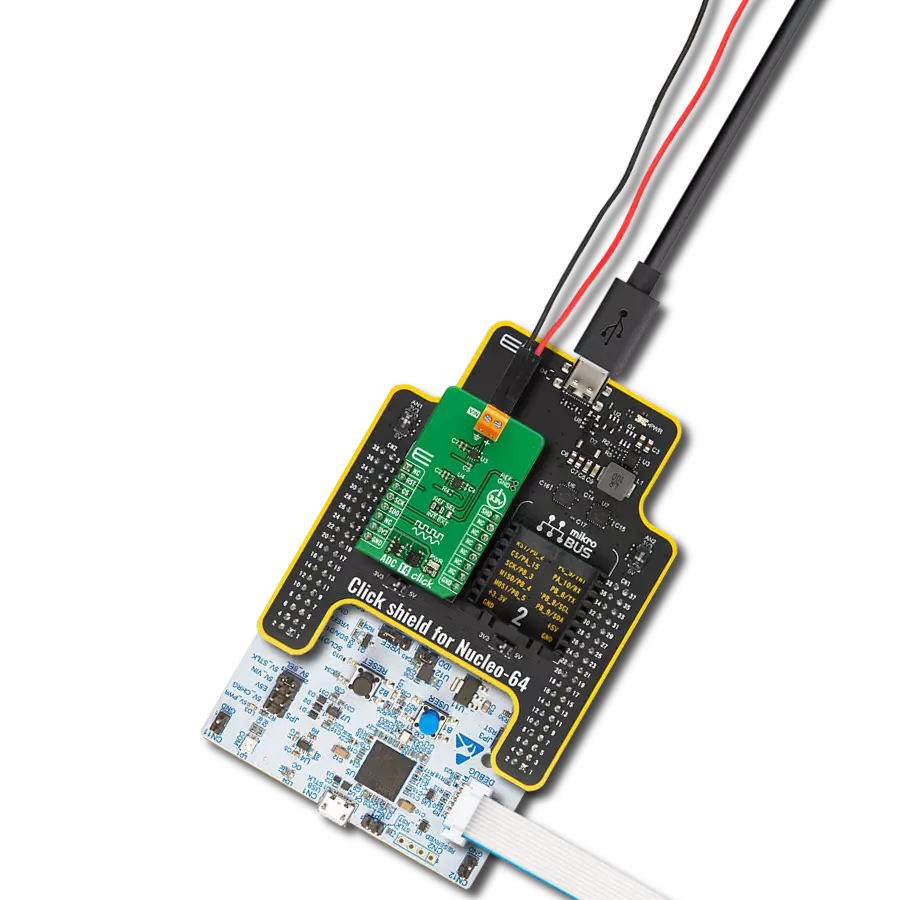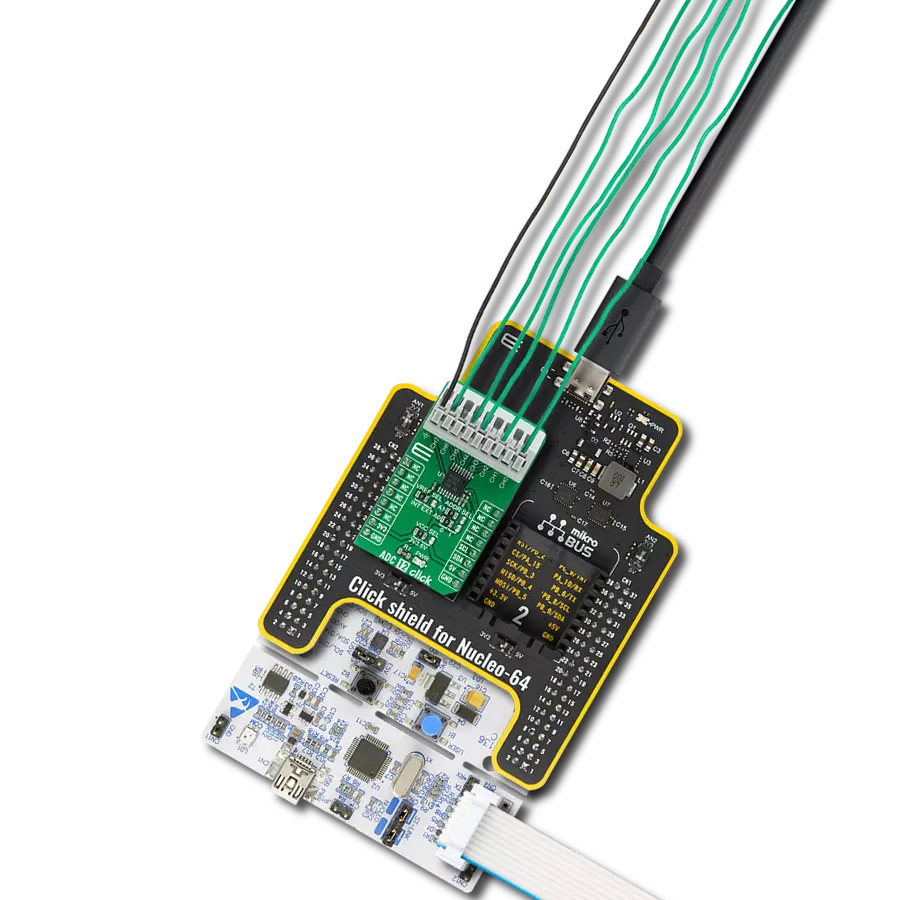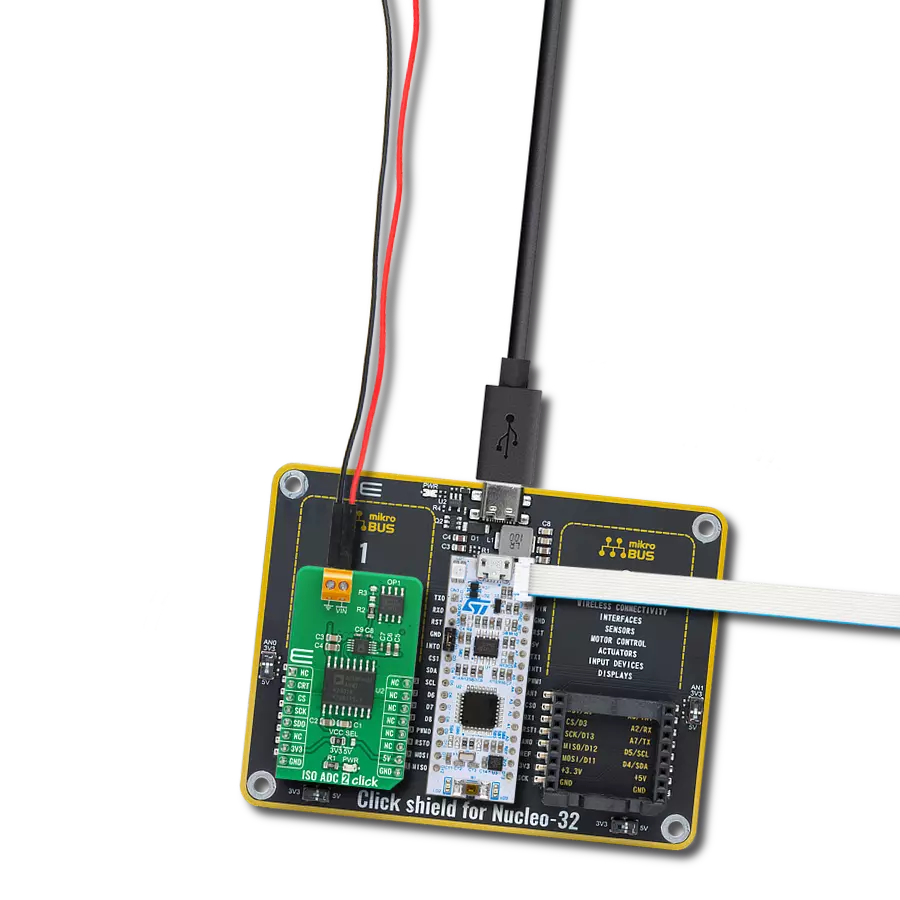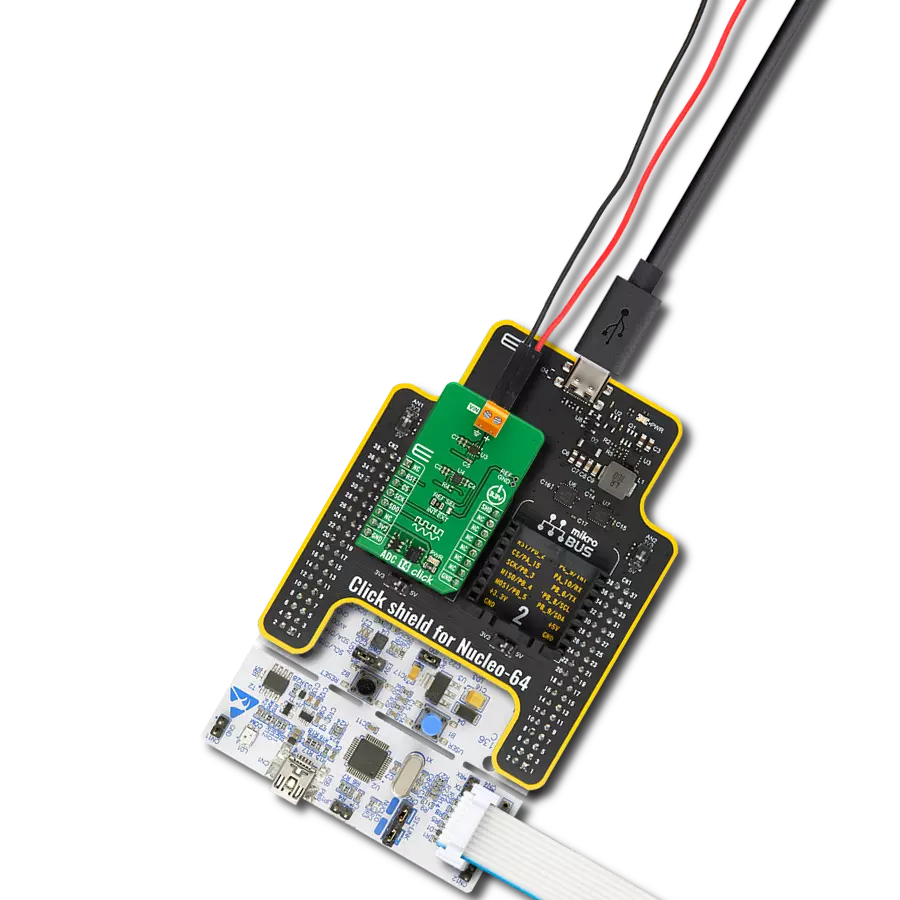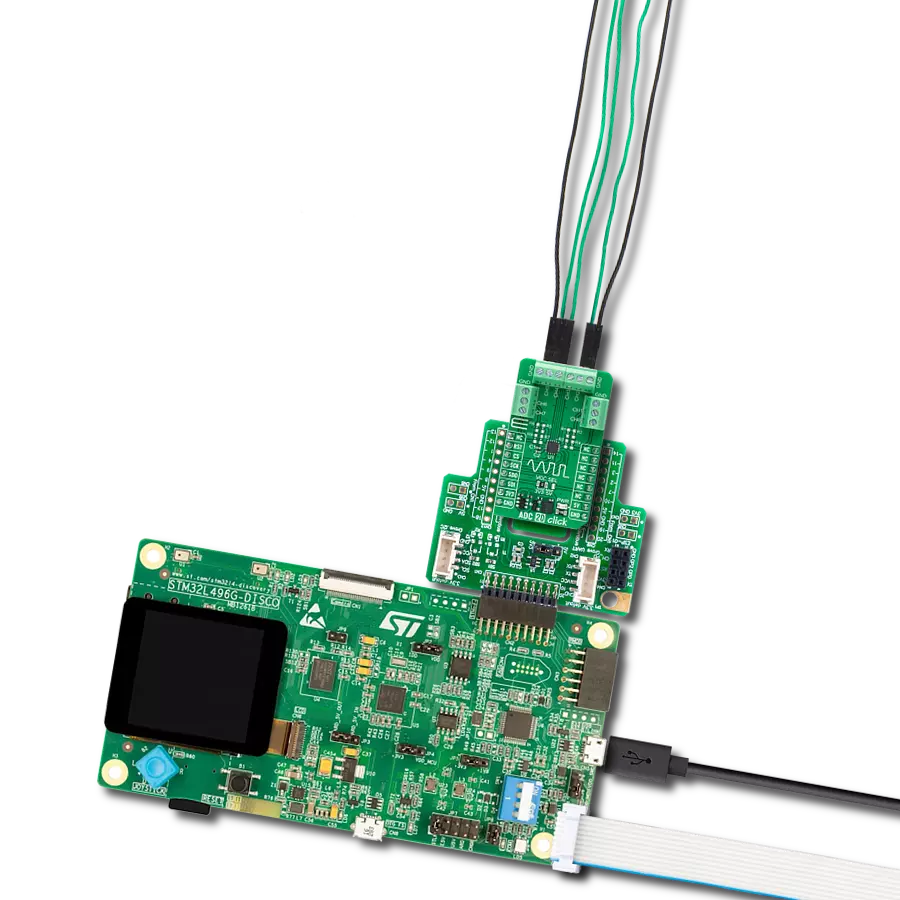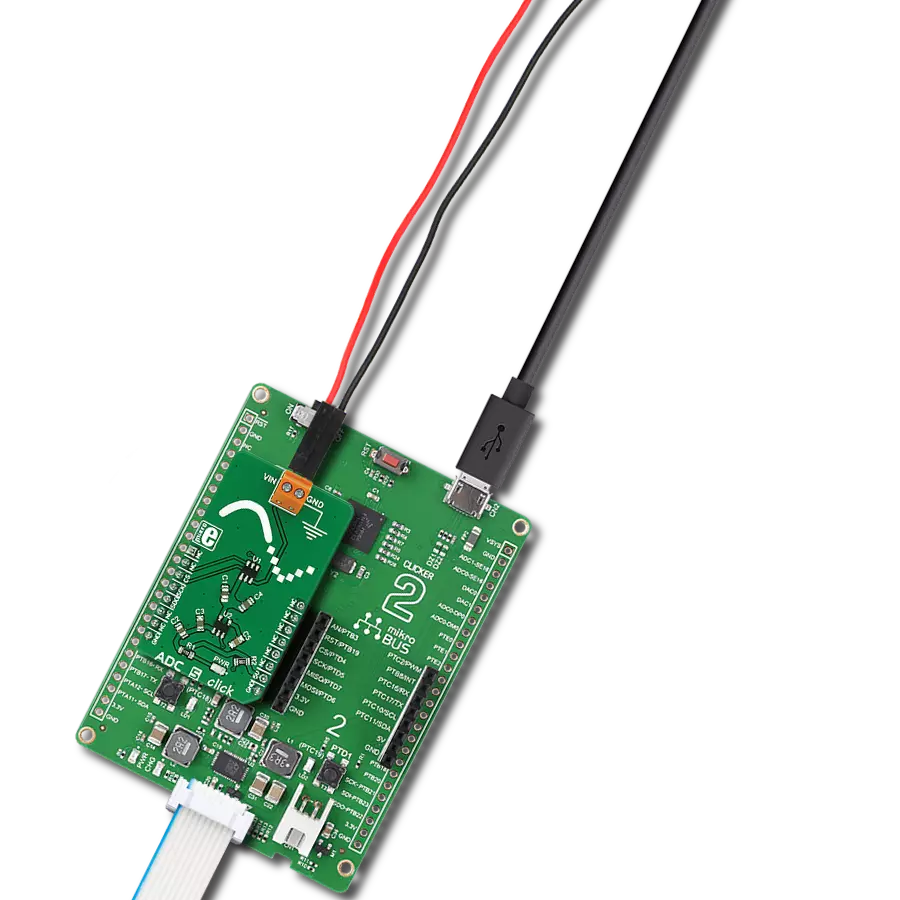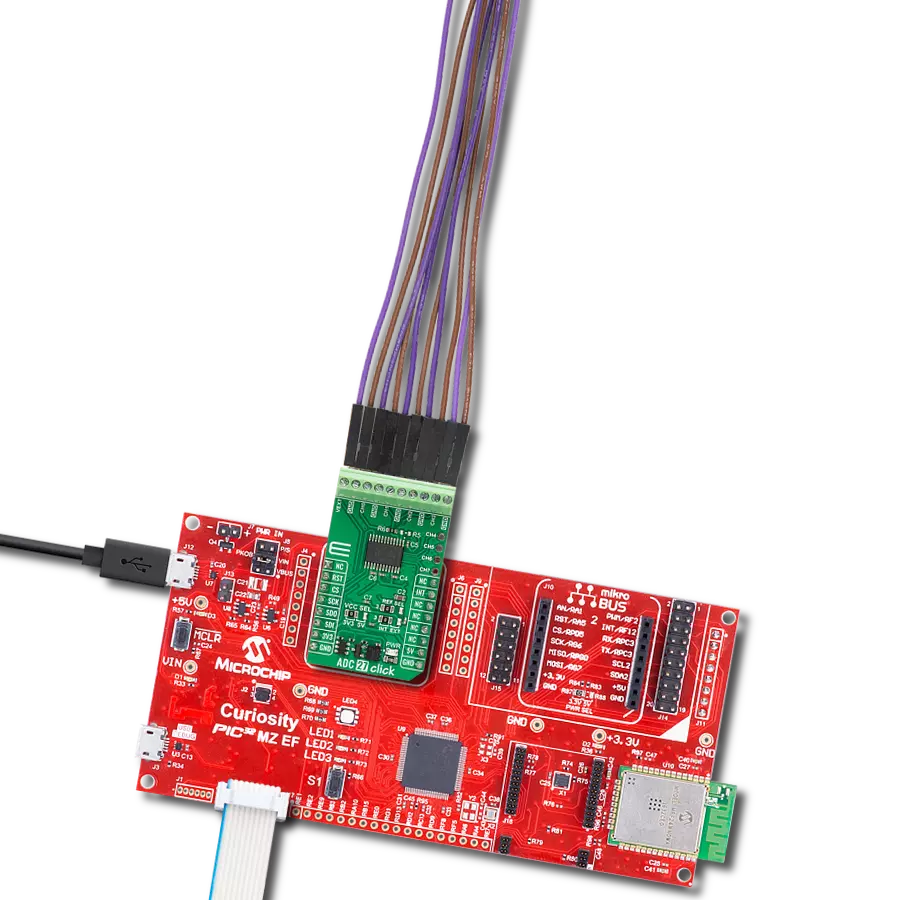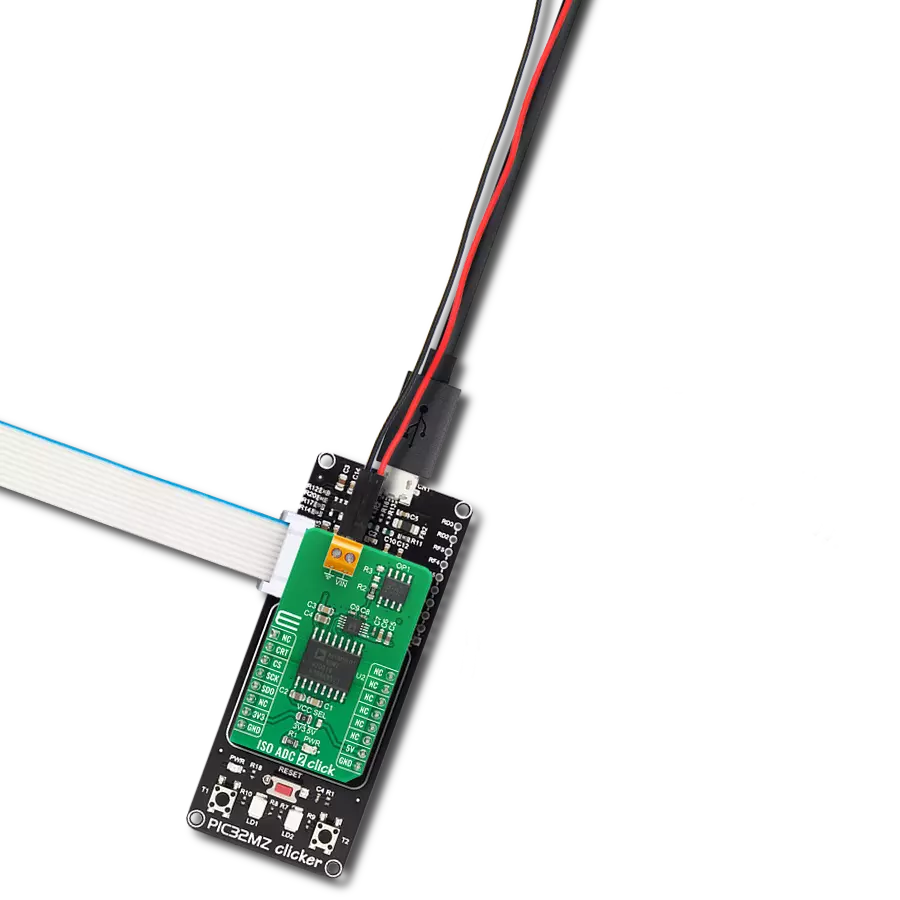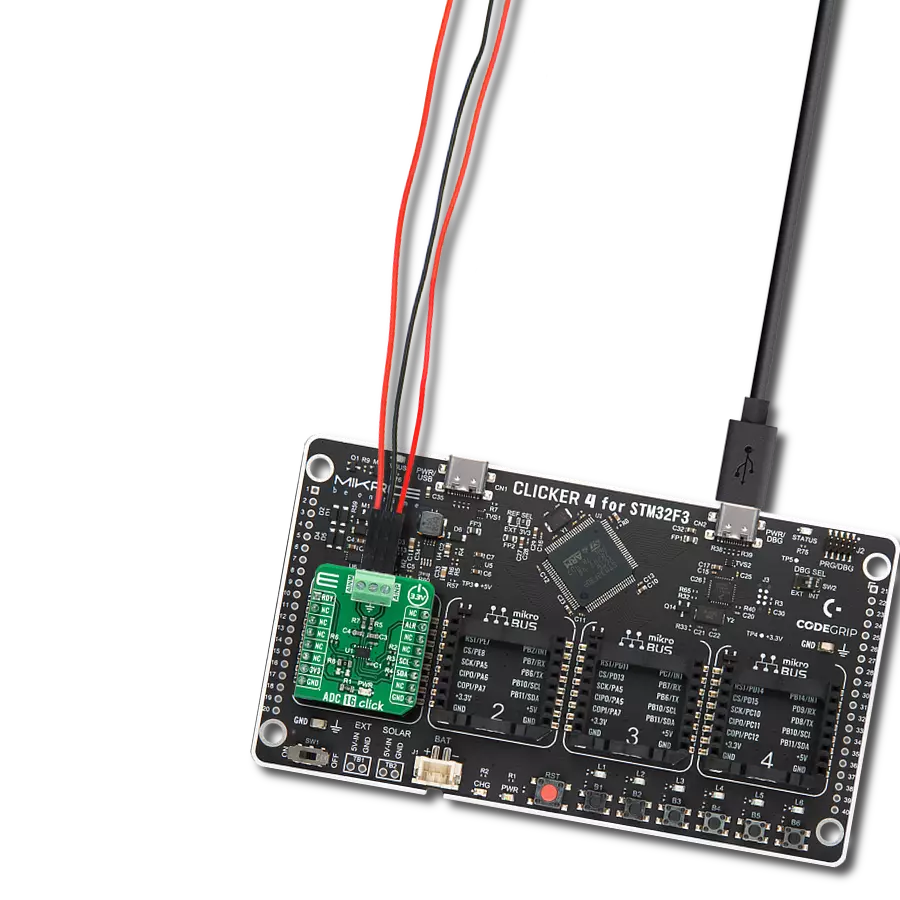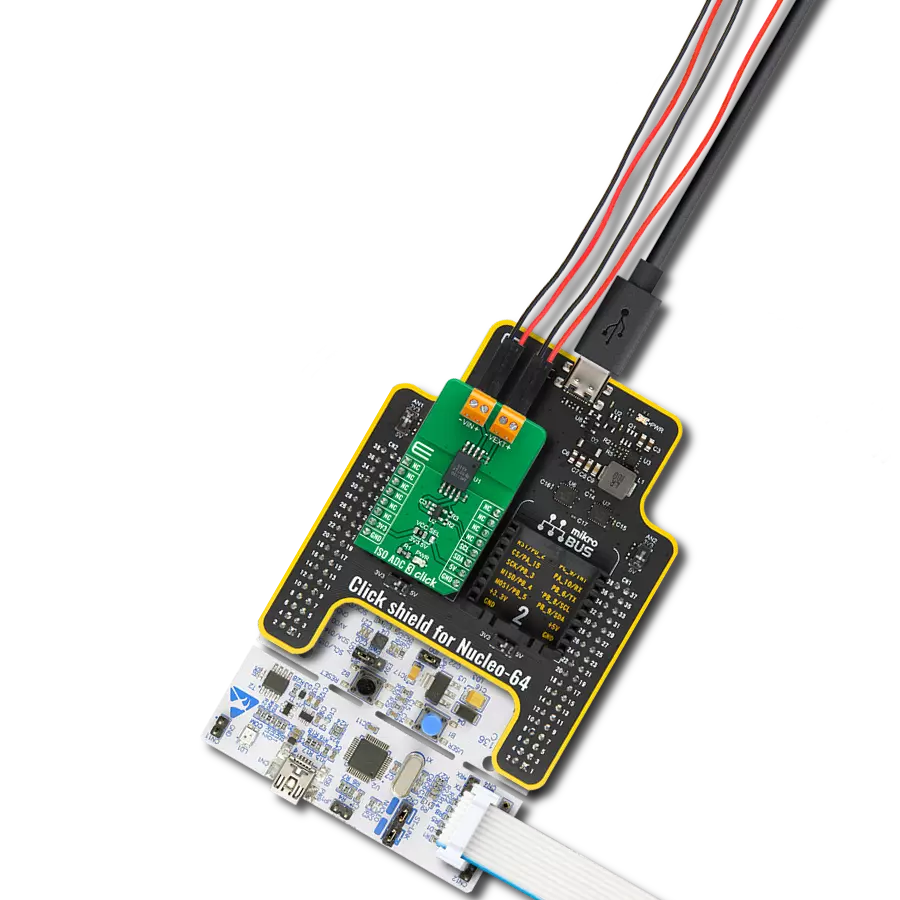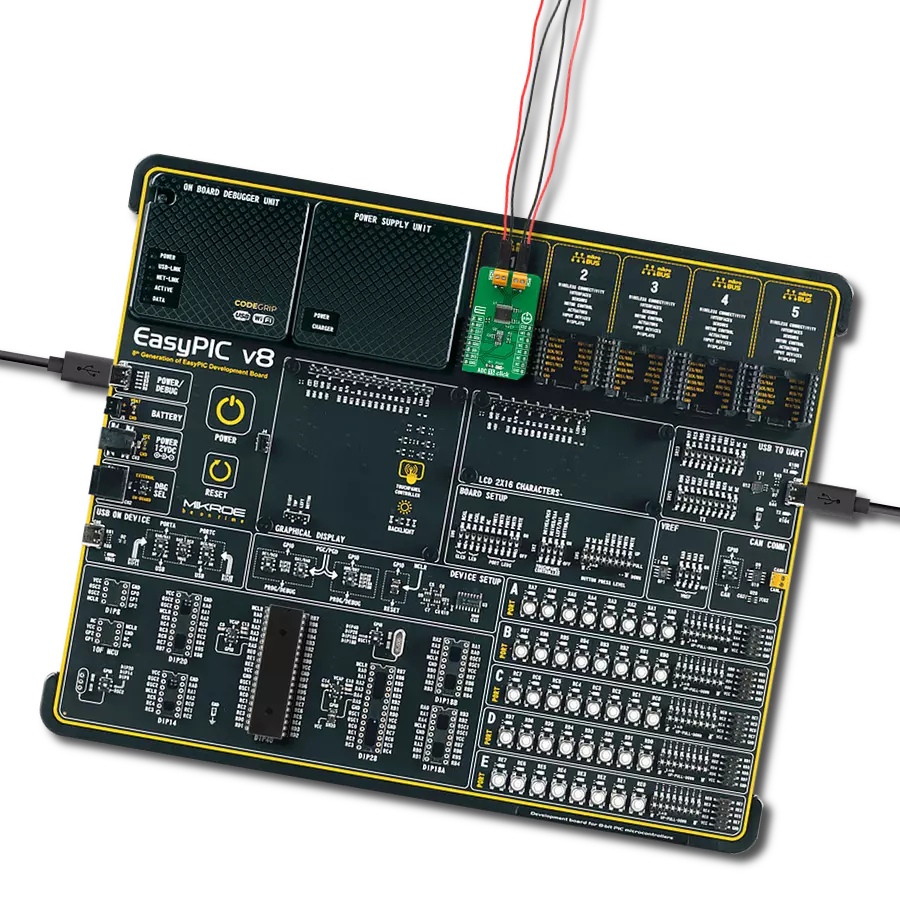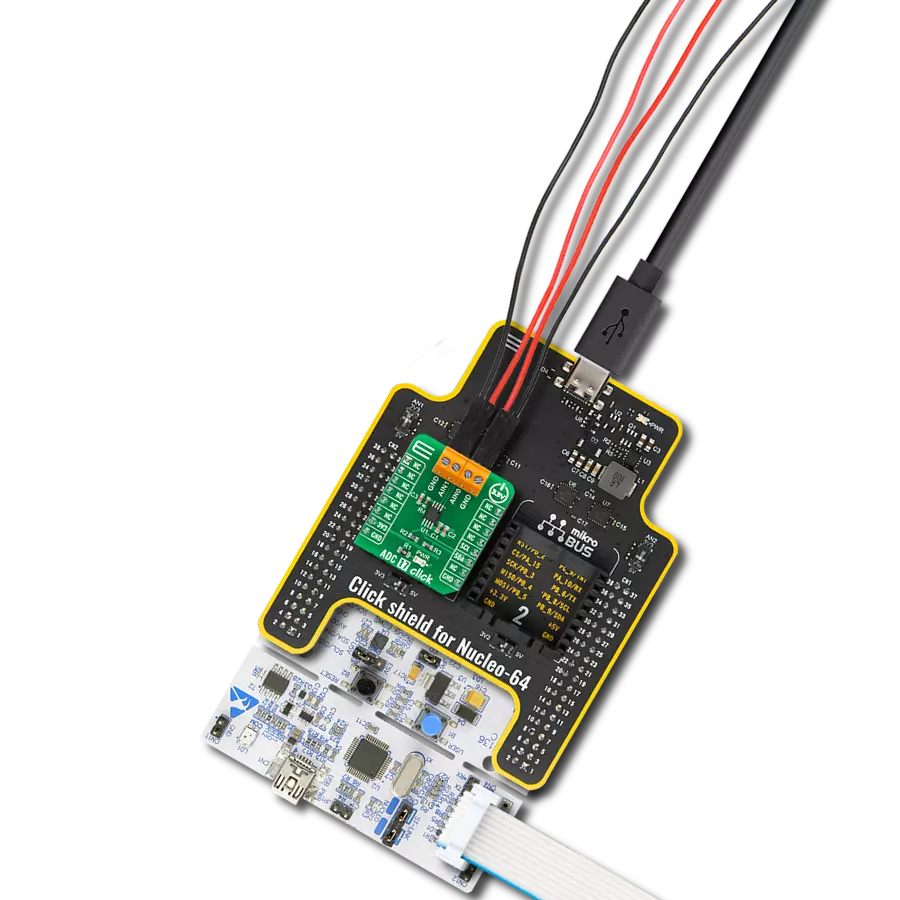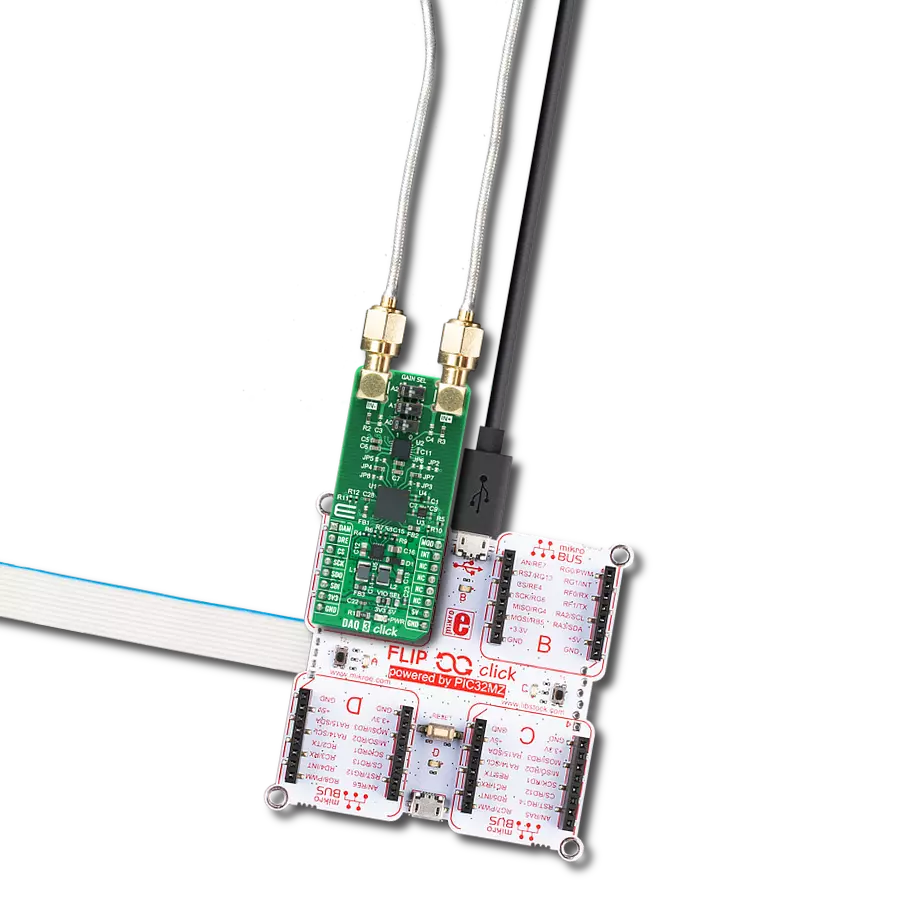Low-power 12-bit analog-to-digital conversion for real-time performance in system monitoring and current sensing
A
A
Hardware Overview
How does it work?
ADC 26 Click is based on the ADS1015L, a low-power 12-bit analog-to-digital converter (ADC) with an I2C-compatible interface from Texas Instruments. It integrates several key components: a ΔΣ ADC core, an internal voltage reference, a clock oscillator, a programmable gain amplifier (PGA), and a programmable digital comparator. This combination enables the ADC to deliver conversions at data rates of up to 3300 samples per second (SPS), making it suitable for applications requiring both high speed and low noise. The ADC core of the ADS1015L measures differential signals brought to its analog input channels (IN0-IN3), offering a flexible full-scale input voltage range from ±0.256V to ±6.144V. This broad range enables the ADS1015L to handle both large and small signals with high precision, making it ideal for general system monitoring tasks such as supply voltage tracking, current sensing, and temperature measurements. These features also cater to applications in wearables and personal electronics. The IC's architecture comprises a differential switched-capacitor ΔΣ modulator followed by a digital filter, ensuring excellent attenuation of common-mode signals and high immunity to noise. The input signal is compared
against the internal voltage reference, while the modulator generates a high-speed bitstream. This stream is processed by the digital filter, which produces a digital output code proportional to the measured voltage. The ADS1015L supports two operational modes designed to optimize power consumption and performance based on application requirements. In single-shot mode, the ADC executes a single measurement upon request, stores the result in an internal register, and then enters a power-down state, making it particularly effective for systems that require periodic measurements or experience extended idle periods between conversions. In continuous-conversion mode, the ADC seamlessly initiates a new measurement as soon as the previous one is completed, maintaining a conversion rate consistent with the configured data rate. This mode is well-suited for real-time monitoring applications, as the data register consistently contains the most recent measurement. This Click board™ is designed in a unique format supporting the newly introduced MIKROE feature called "Click Snap." Unlike the standardized version of Click boards, this feature allows the main IC area to become movable by breaking the PCB, opening up many
new possibilities for implementation. Thanks to the Snap feature, the ADS1015l can operate autonomously by accessing its signals directly on the pins marked 1-8. Additionally, the Snap part includes a specified and fixed screw hole position, enabling users to secure the Snap board in their desired location. ADC 26 Click uses an I2C interface with clock speeds of up to 400kHz, ensuring fast and efficient communication with the host MCU. The I2C address can be easily configured via onboard ADDR SEL jumpers positioned in the Snap part of the board, allowing multiple devices to coexist on the same bus. Additionally, the board features an alert interrupt (AR) pin triggered whenever conversion data exceeds the limit set in the appropriate upper/lower threshold register, or it can be used as a conversion-ready pin. This Click board™ can be operated only with a 3.3V logic voltage level. The board must perform appropriate logic voltage level conversion before using MCUs with different logic levels. It also comes equipped with a library containing functions and example code that can be used as a reference for further development.
Features overview
Development board
Arduino UNO is a versatile microcontroller board built around the ATmega328P chip. It offers extensive connectivity options for various projects, featuring 14 digital input/output pins, six of which are PWM-capable, along with six analog inputs. Its core components include a 16MHz ceramic resonator, a USB connection, a power jack, an
ICSP header, and a reset button, providing everything necessary to power and program the board. The Uno is ready to go, whether connected to a computer via USB or powered by an AC-to-DC adapter or battery. As the first USB Arduino board, it serves as the benchmark for the Arduino platform, with "Uno" symbolizing its status as the
first in a series. This name choice, meaning "one" in Italian, commemorates the launch of Arduino Software (IDE) 1.0. Initially introduced alongside version 1.0 of the Arduino Software (IDE), the Uno has since become the foundational model for subsequent Arduino releases, embodying the platform's evolution.
Microcontroller Overview
MCU Card / MCU
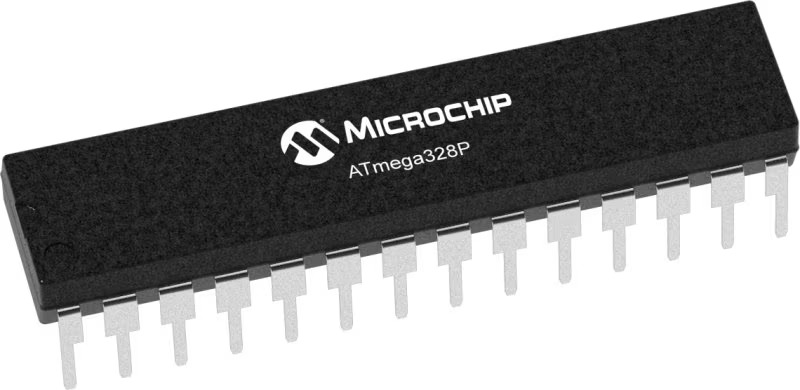
Architecture
AVR
MCU Memory (KB)
32
Silicon Vendor
Microchip
Pin count
28
RAM (Bytes)
2048
You complete me!
Accessories
Click Shield for Arduino UNO has two proprietary mikroBUS™ sockets, allowing all the Click board™ devices to be interfaced with the Arduino UNO board without effort. The Arduino Uno, a microcontroller board based on the ATmega328P, provides an affordable and flexible way for users to try out new concepts and build prototypes with the ATmega328P microcontroller from various combinations of performance, power consumption, and features. The Arduino Uno has 14 digital input/output pins (of which six can be used as PWM outputs), six analog inputs, a 16 MHz ceramic resonator (CSTCE16M0V53-R0), a USB connection, a power jack, an ICSP header, and reset button. Most of the ATmega328P microcontroller pins are brought to the IO pins on the left and right edge of the board, which are then connected to two existing mikroBUS™ sockets. This Click Shield also has several switches that perform functions such as selecting the logic levels of analog signals on mikroBUS™ sockets and selecting logic voltage levels of the mikroBUS™ sockets themselves. Besides, the user is offered the possibility of using any Click board™ with the help of existing bidirectional level-shifting voltage translators, regardless of whether the Click board™ operates at a 3.3V or 5V logic voltage level. Once you connect the Arduino UNO board with our Click Shield for Arduino UNO, you can access hundreds of Click boards™, working with 3.3V or 5V logic voltage levels.
Used MCU Pins
mikroBUS™ mapper
Take a closer look
Click board™ Schematic

Step by step
Project assembly
Software Support
Library Description
This library contains API for ADC 26 Click driver.
Key functions:
adc26_start_conversion- This function starts a single-shot conversion for the selected MUX channel and gain level (full-scale range).adc26_get_alert_pin- This function returns the ALERT (data ready) pin logic state.adc26_read_voltage- This function reads the RAW ADC measurement and converts it to a voltage level.
Open Source
Code example
The complete application code and a ready-to-use project are available through the NECTO Studio Package Manager for direct installation in the NECTO Studio. The application code can also be found on the MIKROE GitHub account.
/*!
* @file main.c
* @brief ADC 26 Click example
*
* # Description
* This example demonstrates the use of ADC 26 Click board by reading and
* displaying the voltage levels from IN0-IN1 differential and IN2-IN3
* single-ended analog input channels.
*
* The demo application is composed of two sections :
*
* ## Application Init
* Initializes the driver and performs the Click default configuration.
*
* ## Application Task
* Reads the voltage levels from IN0-IN1 differential (+/- 2.048V) and
* IN2-IN3 single-ended (+/- 4.096V) analog input channels and displays
* the results on the USB UART once per second approximately.
*
* @note
* Do not apply more than VCC + 0.3 V to the analog inputs of the device.
*
* @author Stefan Filipovic
*
*/
#include "board.h"
#include "log.h"
#include "adc26.h"
static adc26_t adc26;
static log_t logger;
void application_init ( void )
{
log_cfg_t log_cfg; /**< Logger config object. */
adc26_cfg_t adc26_cfg; /**< Click config object. */
/**
* Logger initialization.
* Default baud rate: 115200
* Default log level: LOG_LEVEL_DEBUG
* @note If USB_UART_RX and USB_UART_TX
* are defined as HAL_PIN_NC, you will
* need to define them manually for log to work.
* See @b LOG_MAP_USB_UART macro definition for detailed explanation.
*/
LOG_MAP_USB_UART( log_cfg );
log_init( &logger, &log_cfg );
log_info( &logger, " Application Init " );
// Click initialization.
adc26_cfg_setup( &adc26_cfg );
ADC26_MAP_MIKROBUS( adc26_cfg, MIKROBUS_1 );
if ( I2C_MASTER_ERROR == adc26_init( &adc26, &adc26_cfg ) )
{
log_error( &logger, " Communication init." );
for ( ; ; );
}
if ( ADC26_ERROR == adc26_default_cfg ( &adc26 ) )
{
log_error( &logger, " Default configuration." );
for ( ; ; );
}
log_info( &logger, " Application Task " );
}
void application_task ( void )
{
float voltage = 0;
if ( ADC26_OK == adc26_start_conversion ( &adc26, ADC26_MUX_P_AIN0_N_AIN1, ADC26_PGA_2_048V ) )
{
while ( adc26_get_alert_pin ( &adc26 ) ); // Waits for a data ready indication
if ( ADC26_OK == adc26_read_voltage ( &adc26, &voltage ) )
{
log_printf ( &logger, " Voltage between IN0[P] and IN1[N]: %.3f V\r\n", voltage );
}
}
if ( ADC26_OK == adc26_start_conversion ( &adc26, ADC26_MUX_P_AIN2_N_GND, ADC26_PGA_4_096V ) )
{
while ( adc26_get_alert_pin ( &adc26 ) ); // Waits for a data ready indication
if ( ADC26_OK == adc26_read_voltage ( &adc26, &voltage ) )
{
log_printf ( &logger, " Voltage between IN2 and GND: %.3f V\r\n", voltage );
}
}
if ( ADC26_OK == adc26_start_conversion ( &adc26, ADC26_MUX_P_AIN3_N_GND, ADC26_PGA_4_096V ) )
{
while ( adc26_get_alert_pin ( &adc26 ) ); // Waits for a data ready indication
if ( ADC26_OK == adc26_read_voltage ( &adc26, &voltage ) )
{
log_printf ( &logger, " Voltage between IN3 and GND: %.3f V\r\n\n", voltage );
}
}
Delay_ms ( 1000 );
}
int main ( void )
{
/* Do not remove this line or clock might not be set correctly. */
#ifdef PREINIT_SUPPORTED
preinit();
#endif
application_init( );
for ( ; ; )
{
application_task( );
}
return 0;
}
// ------------------------------------------------------------------------ END
Additional Support
Resources
Category:ADC




















